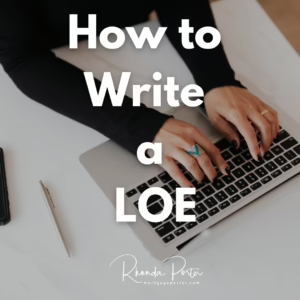 It’s not unusual these days to have a lender request a “letter of explanation” from a home buyer or someone who is buying or refinancing their home. A letter of explanation (or LOE) is often used to help provide more information to the underwriter or lender based on information that is disclosed on an application or credit report. LOE’s may address anything from gaps in employment to inquiries on a credit report and is intended to help explain or add support to the transaction. If a borrower has had an extenuating circumstance and is trying to have an exception made to an underwriting guideline, they may be asked to write a LOE.
It’s not unusual these days to have a lender request a “letter of explanation” from a home buyer or someone who is buying or refinancing their home. A letter of explanation (or LOE) is often used to help provide more information to the underwriter or lender based on information that is disclosed on an application or credit report. LOE’s may address anything from gaps in employment to inquiries on a credit report and is intended to help explain or add support to the transaction. If a borrower has had an extenuating circumstance and is trying to have an exception made to an underwriting guideline, they may be asked to write a LOE.
Buying a Home with Owner Occupied Financing After Refinancing Your Home as Owner Occupied
I’m seeing a trend where home owners are refinancing their current home as “owner occupied” and then weeks after closing, try buying another home as “owner occupied”. You cannot have two owner occupied homes. It’s really that simple.
I’ve had a couple of surprised people contact me who thought they could buy a home just following a refinance only to learn by their mortgage originator that they have to finance the new home as an investment property. Financing an investment property not only offers a slightly higher interest rate than a mortgage for a primary residence, it also has tougher guidelines with higher down payment requirements and greater reserves (savings).
If you are considering refinancing your primary residence and possibly buying another home, you should discuss this with your mortgage originator as soon as possible. You will be signing a deed of trust which has language that you intend to occupy that home for 12 months. Some folks might feel that the “intending to occupy” means that they can refinance as owner occupied and a couple months later buy “owner occupied” and odds are, they will be caught. It may be purely unintended for this to happen, but be prepared for the possibility the new purchase to be treated as an investment property, even if you’re going to live there.
If you’re considering taking advantage of the lower home prices and lower rates, you may want to delay your refinance of your current “primary residence” or talk to your mortgage originator about refinancing your current home as an investment property. Your next purchase might qualify as a second home, however the property typically needs to be about 50 miles away from your primary residence (the one you just refinanced) and it is the underwriter’s call on whether or not the second home “makes sense”…this can be a real grey area.
Life happens and we know plans change. Be upfront with your mortgage professional if you’re thinking about buying a home. You may want to ask them to verify with your personal scenario with an underwriter. Finding yourself in the middle of a transaction to buy your next home and having it declined as owner occupied can be an expensive experience.
Related post:
Is it a Primary Residence, Second Home or Investment Property
Can I Convert My Existing Home to an Investment Property to Buy My Next Home?








Recent Comments